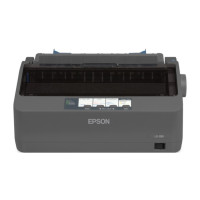Paper that has sprocket-feed holes on both sides, is perforated between pages, and is supplied in a folded stack. Also called
continuous paper.
font
A style of type designated by a name such as Roman or Sans Serif.
form feed (FF)
A control code and control panel button that advances the paper to the next top-of-form position.
halftoning
A method of using dot patterns to represent an image. Halftoning makes it possible to produce varying shades of gray using
only black dots, or a nearly infinite array of colors using only a few colors of dots.
hex dump
A troubleshooting method that helps identify the cause of communication problems between the printer and the computer.
When the printer is in hex dump mode, it prints each code that it receives in hexadecimal notation and ASCII characters. Also
called data dump.
high speed draft
A mode of draft printing you can select using the default-setting mode. High speed draft uses a minimum number of dots per
character to produce extremely high-speed printing.
interface
The connection between the computer and the printer over which print data is transmitted to the printer.
landscape
Printing that is oriented sideways on the page. This orientation gives you a page that is wider than it is high and is useful for
printing spreadsheets.
letter quality (LQ)
The print mode used by your printer when a font other than Draft is selected. Printing with letter-quality fonts provides better
readability and appearance at a reduced print speed.
line feed (LF)
A control code and control panel button that advances the paper one line space.
loading position
The position to which the paper is automatically loaded.
micro adjust
A printer feature that allows you to precisely adjust the tear-off and top-of-form positions.
near letter quality (NLQ)
The print mode used by your printer when a font other than Draft is selected. Printing with NLQ fonts provides better
readability and appearance at a reduced print speed.
paper positions
There are three paper positions for continuous paper printing: standby, tear-off, and top-of-form. For single sheet printing,
there is only the top-of-form position.
pitch
The size of the font, which is measured in the number of characters per inch (cpi). The standard is 10 cpi.
platen
The black flat part that provides a backing for the paper during printing.
portrait
Printing that is oriented upright on the page (as opposed to landscape, in which printing is sideways on the page). This is the
standard orientation for printing letters or documents.
printer driver
A software program that sends commands from the computer for using the functions of a particular printer.
printing start position
The horizontal position on the paper that the printer recognizes as the first printable column. You can adjust the printing start
position with the control panel.
proportional font
A font whose characters take up varying amounts of horizontal space depending on the width of the character. Thus the
uppercase M takes up more horizontal space than the lowercase l.
recommended printable area
The area of a page on which the printer can print. It is smaller than the physical size of the page due to margins.

